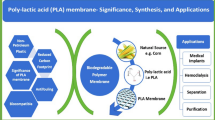Abstract
Porcine liver esterase was immobilized in polyacrylamide gel for the enantioselective production of levofloxacin from ofloxacin butyl ester. The initial activity of immobilized esterase was found to be significantly affected by the polyacrylamide gel composition. The optimum concentrations of monomer and crosslinker were determined to be 20% and 8.3%, respectively. The activity of immobilized esterase was 55.4% compared to a free enzyme. Enantiomeric excess was maintained at 60%, almost the same level as that of free enzyme. In addition, the immobilized esterase could be used repeatedly up to 10 times without experiencing any severe loss of activity and enantioselectivity.
Similar content being viewed by others
References
Lee, E. G. and B. H. Chung (2000) Chiral resolution using enzymes.Kor. J. Biotechnol. Bioeng. 15: 415–422.
Kim, M. G. and S. B. Lee (1996) Enzymatic resolution of racemic ibuprofen by lipase-catalyzed esterification reactions Effects of water content and solid supports.J. Ferment. Bioeng. 81: 269–271.
Vicerzi, J. T., M. J. Zmijewski, M. R. Reinhard, B. E. Landen, W. L. Muth, and P. G. Marler (1997) Large-scale stereoselective enzymatic ketone reduction within situ product removal via polymeric adsorbent resins.Enzyme Microb. Technol. 20: 494–499.
Gokul, B., J. H. Lee, K. B. Song, T. Panda, S. K. Rhee, and C. H. Kim (2000) Screening of microorganisms producing esterase for the production of (R)-β-acetylmercaptoisobutyric acid from (R,S)-β-acetylmercaptoisobutyrate with (R,S)-acetylmercaptoisobutyrate methyl ester.Biotechnol. Bioprocess Eng. 5: 57–60.
Jaeger, K. E. and M. T. Reetz (2000) Directed evolution of enantioselective enzymes for organic chemistry.Curr, Opin. Chem. Biol. 4: 68–73.
Kim B. Y., K. C. Hwang, H. S. Song, N. H. Chung, and W. K. Bang (2000) Optical resolution of RS(±)-mandelic acid byPseudomonas sp.Biotechnol. Lett. 22: 1871–1875.
Frings, L., M. Koch, and W. Hartmeier (1999) Kinetic resolution of 1-phenyl ethanol with high enantioselectivity with native and immobilized lipase in organic solvents.Enzyme Microb. Technol. 25: 303–309.
Jaeger, K. E. and M. T. Reetz (1998) Microbial lipases form versatile tools for biotechnology.Trends Biotechnol. 16: 396–403.
Tischer, W. and E. Wedekind (1999) Immobilized enzymes: Methods and Applications.Topics Curr. Chem. 200: 95–126.
Martinez-Martinez L., A. Pascual, A. I. Suarez, and E. J. Perea (1999)In-vitro activity of levofloxacin, ofloxacin andd-ofloxacin against coryneform bacteria andListeria monocytogenes.J. Antimicrob. Chemother. 43: 27–32.
Lee S.-Y., B.-H. Min, S.-H. Hwang, Y.-M. Koo, C.-G. Lee, S.-W. Song, S.-Y. Oh, S.-M. Lim, S.-L. Kim, and D.-I. Kim (2000) Enantioselective production of levofloxacin from ofloxacin butyl ester by porcine liver esterase.Ker. J. Biotechnol. Bioeng. 15: 313–317.
Liu B. L., C. H. Jong, and Y. M. Tzeng (1999) Effect of immobilization on pH and thermal stability ofAspergillus ficuum phytase.Enzyme Microb. Technol. 25: 517–521.
Cao S. G., H. Yang, L. Ma, and S. Q. Guo (1996) Enhancing enzymatic properties by the immobilization method.Appl. Biochem. Biotechnol. 59: 7–14.
Pizarro, C., M. A. Fernandez-Torroba, C. Benito, and J. M. Gonzalez-Saiz (1997) Optimization by experimental design of polyacrylamide gel composition as support for enzyme immobilization by entrapmen.Biotechnol. Broeng. 53: 497–506.
Sánchez, E. M., J. F. Bello, M. G. Roig, F. J. Burguillo, J. M. Moreno, and J. V. Sinister (1996) Kinetic and enantioselective behavior of the lipase fromCandida cylindracea: Comparative study between the soluble enzyme and the enzyme immobilized on agarose and silica gels.Enzyme Microb. Technol. 18: 468–476.
Palmer, T. (1995)Understanding Enzymes. 4th ed., pp. 356–365. Prentice Hall/Ellis Horwood, New York, USA.
Das, N., A. M. Kayastha, and O. P. Malhotra (1998) Immobilization of urease from pigeonpea (Cajanus cajar L.) in polyacrylamide gels and calcium alginate headsBiotechnol. Appl. Biochem. 27: 25–29.
Pizarro, C., M. A. Fernandez-Torroba, C. Benito, and J. M. Gonzales-Saiz (1997) Optimization by experimental design of polyacrylamide gel composition as support for enzyme immobilization by entrapment.Biotechnol. Bioeng. 53: 497–506.
Author information
Authors and Affiliations
Corresponding author
Rights and permissions
About this article
Cite this article
Lee, SY., Min, BH., Song, SW. et al. Polyacrylamide gel immobilization of porcine liver esterase for the enantioselective production of levofloxacin. Biotechnol. Bioprocess Eng. 6, 179–182 (2001). https://doi.org/10.1007/BF02932547
Received:
Accepted:
Issue Date:
DOI: https://doi.org/10.1007/BF02932547




